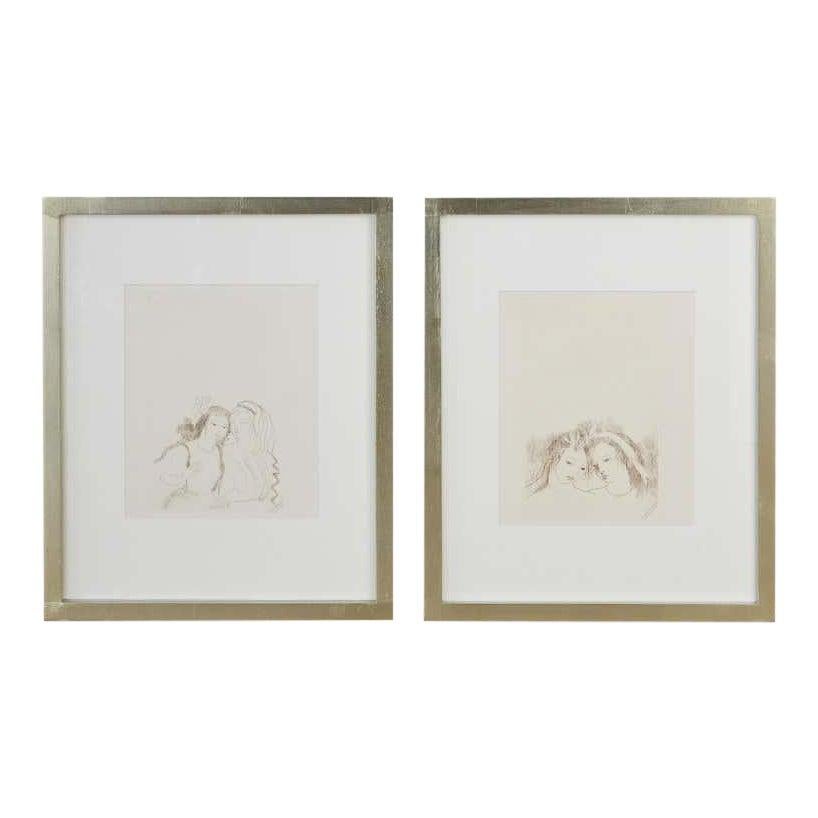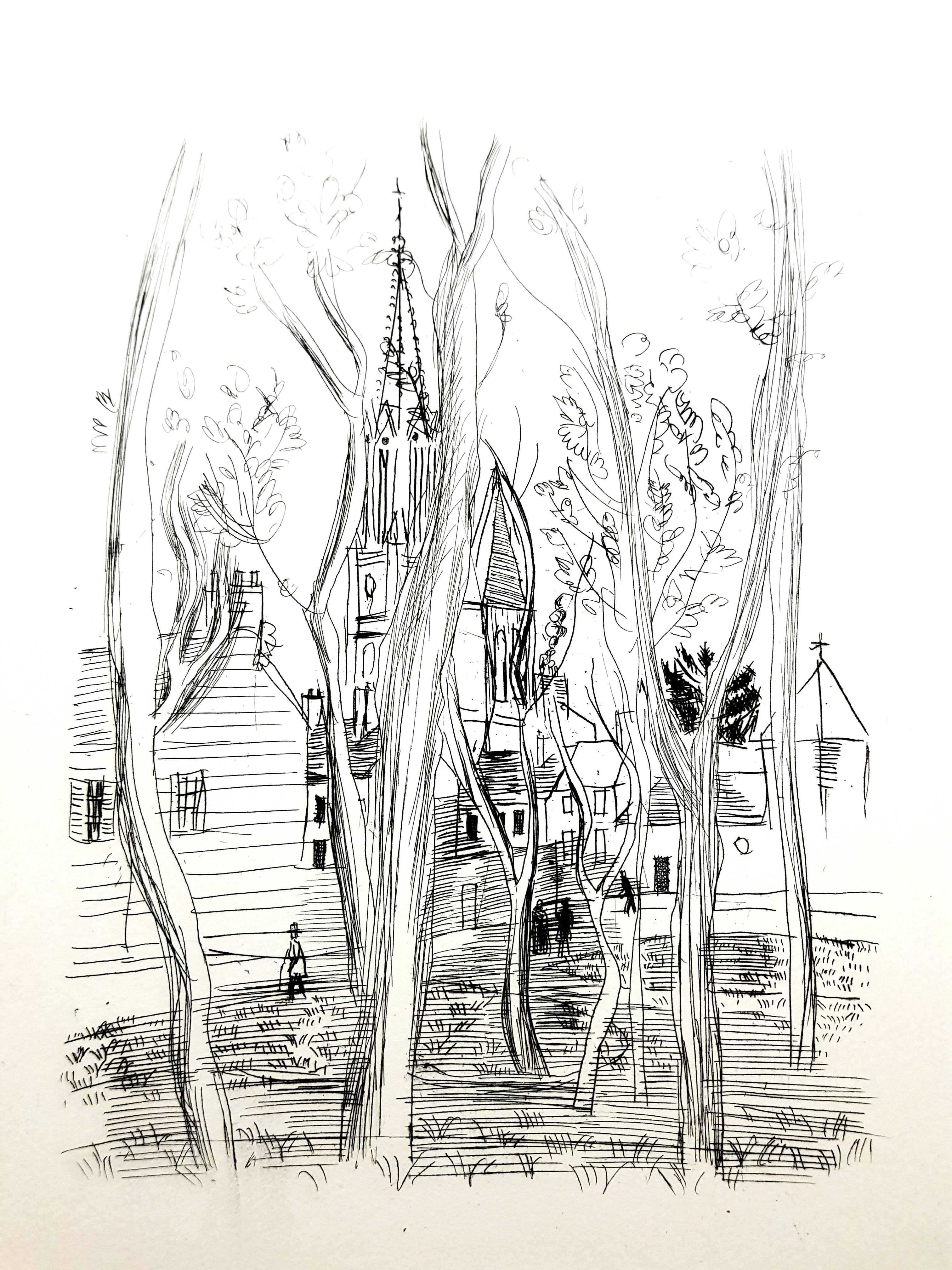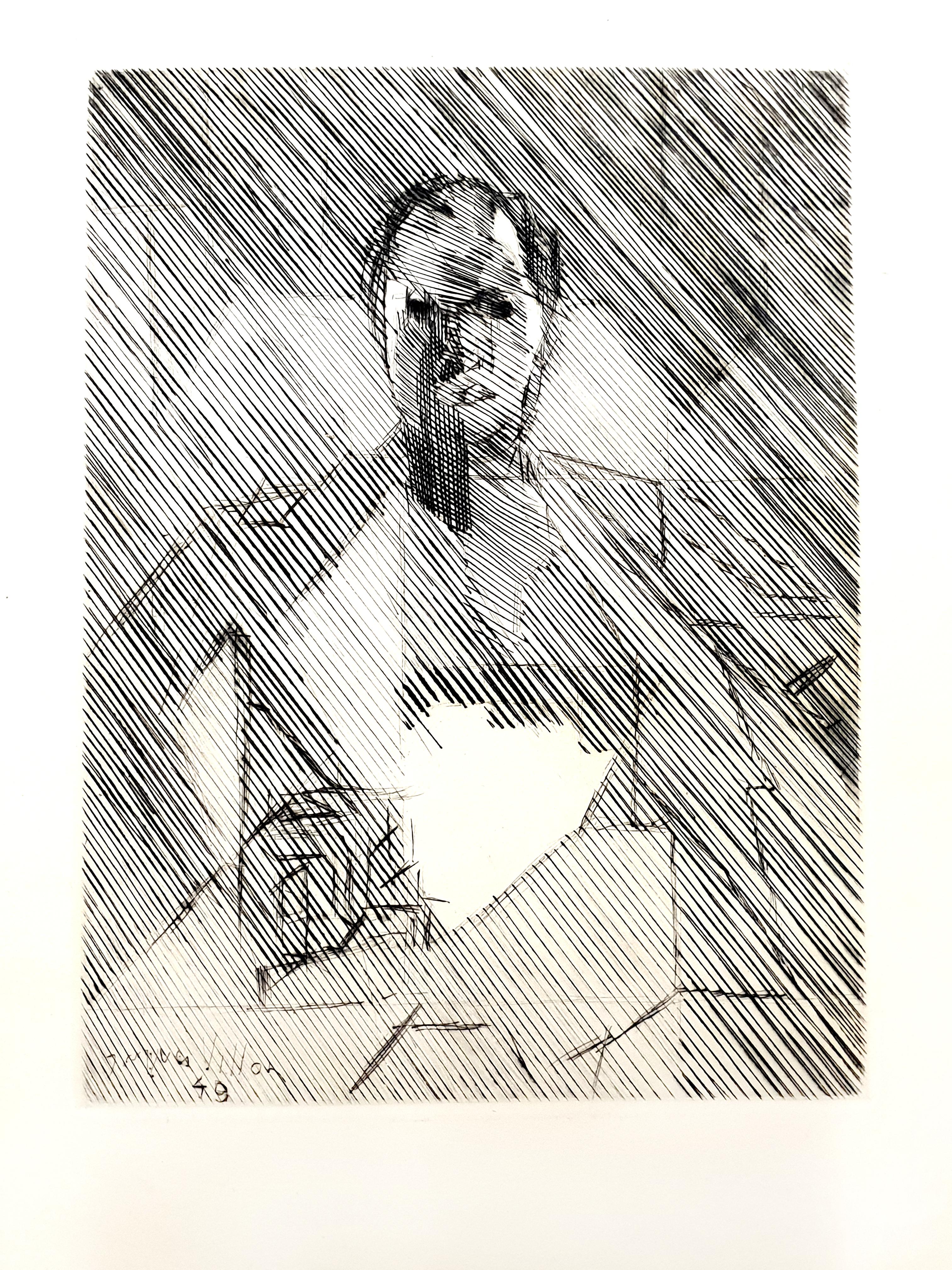Items Similar to Jacques Villon - Woman - Original Etching
Want more images or videos?
Request additional images or videos from the seller
1 of 9
Jacques VillonJacques Villon - Woman - Original EtchingCirca 1949
Circa 1949
About the Item
Jacques Villon - Woman - Original Etching
Circa 1949
Signed in pencil and numbered
Dimensions : 34.8 x 25 cm
- Creator:Jacques Villon (1875-1963, French)
- Creation Year:Circa 1949
- Dimensions:Height: 13.71 in (34.8 cm)Width: 9.85 in (25 cm)Depth: 0.04 in (1 mm)
- Medium:
- Movement & Style:
- Period:
- Condition:
- Gallery Location:Collonge Bellerive, Geneve, CH
- Reference Number:1stDibs: LU16124429961
About the Seller
4.9
Platinum Seller
These expertly vetted sellers are 1stDibs' most experienced sellers and are rated highest by our customers.
Established in 2015
1stDibs seller since 2015
907 sales on 1stDibs
Typical response time: 1 hour
- ShippingRetrieving quote...Ships From: Collonge Bellerive, Geneve, Switzerland
- Return PolicyA return for this item may be initiated within 7 days of delivery.
More From This SellerView All
- Raoul Dufy - Village - Original EtchingBy Raoul DufyLocated in Collonge Bellerive, Geneve, CHRaoul Dufy - Village - Original Etching Dimensions: 13 x 10". Edition of 200 1940 Edition Les Bibliophiles du Palais, Paris Raoul Dufy Born in 1877, the French painter Raoul Dufy wa...Category
1940s Modern Portrait Prints
MaterialsEtching
- Jacques Villon - Man - Original EtchingBy Jacques VillonLocated in Collonge Bellerive, Geneve, CHJacques Villon - Man- Original Etching 1951 Signed in pencil and numbered Dimensions : 34.8 x 25 cmCategory
1950s Modern Portrait Prints
MaterialsEtching
- Jacques Villon - Cubist Man - Original EtchingBy Jacques VillonLocated in Collonge Bellerive, Geneve, CHJacques Villon - Man- Original Etching 1949 Signed in the plate Dimensions : 44.5 x 32.5 cmCategory
1940s Modern Portrait Prints
MaterialsEtching
- Raoul Dufy - Beauty - Original EtchingBy Raoul DufyLocated in Collonge Bellerive, Geneve, CHRaoul Dufy - Beauty - Original Etching Dimensions: 13 x 10". Edition of 200 1940 Edition Les Bibliophiles du Palais, Paris Raoul Dufy Born in 1877, the French painter Raoul Dufy was...Category
1940s Modern Portrait Prints
MaterialsEtching
- Raoul Dufy - A L'Ecu de France - Original EtchingBy Raoul DufyLocated in Collonge Bellerive, Geneve, CHRaoul Dufy - A L'Ecu de France - Original Etching From the limited edition book "Aphorismes et Varietes" by Brillat Savarin with 20 illustrations by Dufy Dimensions: 13 x 10". Editio...Category
1940s Modern Portrait Prints
MaterialsEtching
- Pablo Picasso - Seated Woman - Original EtchingBy Pablo PicassoLocated in Collonge Bellerive, Geneve, CHPablo Picasso - Seated Woman - Original Etching Signed and dated in the plate 1943 Edition: 200 Dimensions: 18.5 x 28 cm Platemark size : 13.2 x 24.5 Material: LaFuMa paper, watermark on the lower right Reference: Bloch 362; Baer 689Bb; Cramer 39; Elliott, Picasso on Paper, National Galleries of Scotland, 2007, illustrated p.84 Pablo Picasso Picasso is not just a man and his work. Picasso is always a legend, indeed almost a myth. In the public view he has long since been the personification of genius in modern art. Picasso is an idol, one of those rare creatures who act as crucibles in which the diverse and often chaotic phenomena of culture are focussed, who seem to body forth the artistic life of their age in one person. The same thing happens in politics, science, sport. And it happens in art. Early life Born in Malaga, Spain, in October of 1881, he was the first child born in the family. His father worked as an artist, and was also a professor at the school of fine arts; he also worked as a curator for the museum in Malaga. Pablo Picasso studied under his father for one year, then went to the Academy of Arts for one year, prior to moving to Paris. In 1901 he went to Paris, which he found as the ideal place to practice new styles, and experiment with a variety of art forms. It was during these initial visits, which he began his work in surrealism and cubism style, which he was the founder of, and created many distinct pieces which were influenced by these art forms. Updates in style During his stay in Paris, Pablo Picasso was constantly updating his style; he did work from the blue period, the rose period, African influenced style, to cubism, surrealism, and realism. Not only did he master these styles, he was a pioneer in each of these movements, and influenced the styles to follow throughout the 20th century, from the initial works he created. In addition to the styles he introduced to the art world, he also worked through the many different styles which appeared, while working in Paris. Not only did he continually improve his style, and the works he created, he is well known because of the fact that he had the ability to create in any style which was prominent during the time. Russian ballet In 1917, Pablo Picasso joined the Russian Ballet, which toured in Rome; during this time he met Olga Khoklova, who was a ballerina; the couple eventually wed in 1918, upon returning to Paris. The couple eventually separated in 1935; Olga came from nobility, and an upper class lifestyle, while Pablo Picasso led a bohemian lifestyle, which conflicted. Although the couple separated, they remained officially married, until Olga's death, in 1954. In addition to works he created of Olga, many of his later pieces also took a centralized focus on his two other love interests, Marie Theresa Walter and Dora Maar. Pablo Picasso remarried Jacqueline Roque in 1961; the couple remained married until his death 12 years later, in 1973. Work as a pacifist Pablo Picasso was a pacifist, and large scale paintings he created, showcased this cry for peace, and change during the time. A 1937 piece he created, after the German bombing of Guernica, was one such influential piece of the time. Not only did this become his most famous piece of art work, but the piece which showed the brutality of war, and death, also made him a prominent political figure of the time. To sell his work, and the message he believed in, art, politics, and eccentricity, were among his main selling points. Conflicting with social views Many things Pablo Picasso did during the 1950s, conflicted with the general public. Viciousness towards his children, exaggerated virility towards women, and joining the Communist party, were some of the many scandals which he was involved in during his lifetime. Although most of the things he did were viewed negatively by a minority of the general public, admirers of Pablo Picasso turned a blind eye, and still accepted him as a prominent figure in their society. Following the end of WWII, Pablo Picasso turned back towards his classic style of work, and he created the "Dove of Peace." Even though he became a member of the Communist party, and supported Stalin and his political views and rule, Pablo Picasso could do no wrong. In the eyes of his admirers and supporters, he was still a prominent figure, and one which they would follow, regardless of what wrongs he did. He was not only an influence because of the works he created, but he was also an influential figure in the political realm. Influence outside of art Although Pablo Picasso is mainly known for his influence to the art world, he was an extremely prominent figure during his time, and to the 20th century in general. He spread his influences to the art world, but also to many aspects of the cultural realm of life as well. He played several roles in film, where he always portrayed himself; he also followed a bohemian lifestyle, and seemed to take liberties as he chose, even during the later stages of his life. He even died in style, while hosting a dinner party in his home. Collection of work Pablo Picasso is recognized as the world's most prolific painter. His career spanned over a 78 year period, in which he created: 13,500 paintings, 100,000 prints and engravings, and 34,000 illustrations which were used in books. He also produced 300 sculptures and ceramic pieces during this expansive career. It is also estimated that over 350 pieces which he created during his career, have been stolen; this is a figure that is far higher than any other artist throughout history. Sale of his works Pablo Picasso has also sold more pieces, and his works have brought in higher profit margins, than any other artist of his time. His pieces rank among the most expensive art...Category
1940s Modern Figurative Prints
MaterialsEtching
You May Also Like
- "Two Women" Pair EtchingsBy Marie LaurencinLocated in Rio Vista, CAElegant pair of etchings by Marie Laurencin (French 1883-1956) from the "Poemes de Sapho" published in 1950 ref. 273. Each beautifully mounted in fram...Category
20th Century Modern Portrait Prints
MaterialsEtching
- Three studies of Bloom Richard Hamilton James Joyce Ulysses illustration printBy Richard HamiltonLocated in New York, NYRichard Hamilton began studying James Joyce's novel Ulysses (1922) during his national service in 1947. Hamilton was inspired by the idea of illustrating Joyce’s complex, experimental novel in and began making sketches the following year, only to put the project to one side in 1950, with no publisher willing to front the exorbitant cost of resetting the novel for illustrations. It was not until 1981 that he made the decision to create one illustration for each of the novel’s eighteen chapters, and a nineteenth image – a portrait of one of the novel’s main protagonists, Leopold Bloom – destined as a frontispiece. He conceived these images as large intaglio...Category
1940s Modern Portrait Prints
MaterialsEngraving, Etching
- Dorian Gray at Opium Den from "The Picture of Dorian Gray" surreal portraitBy Jim DineLocated in New York, NYThis surreal etching portrait of Dorian Gray by Jim Dine in blue ink features the literary protagonist dressed in a white suit. His face is obscured by a mass of hair, tangles of which seem to grow from the sleeves, pant legs, and from beneath the jacket. Dine's notes are written on the image: at his feet reading "WHITE BOOTS" and "White Vinyl Suit" alongside the jacket. On the left edge of the image handwritten text reads "DORIAN GRAY AT OPIUM DEN". In Oscar Wilde's novel Dorian Gray keeps opium in an ornate box in his home, and frequents sites of consumption on the East side of London: “There were opium dens where one could buy oblivion, dens of horror where the memory of old sins could be destroyed by the madness of sins that were new”. An opium den is where Sybil's brother James discovers Dorian. The brother attempts to capture the man he believes is responsible for the death of his sister. Dorian flees to his home, ultimately slashing the portrait that has kept him young for so long. Etching by Jim Dine from one of his most important artist’s books – completely designed and illustrated by Dine. Study for the Rings on Dorian Gray’s Hand from “The Picture of Dorian Gray...Category
1960s Modern Figurative Prints
MaterialsEtching
- Will Barnet Early Important Figural B&W Etching American 1940 Framed RareBy Will BarnetLocated in Buffalo, NYA nice rare early etching by the noted American Artist Will Barnet titled "Mary", created in 1936.Category
1930s American Modern Figurative Prints
MaterialsPaper, Etching
- Maison close. Bavardages, avec perroque, Célestine, et le portrait de DegasBy Pablo PicassoLocated in Wien, 9- stampsignature on the lower right - numbered 27/50 lower left - dated in the plate dimanche 4. avril 1971 - Plate 109 from the Suite 156 - cat.raisonné Bloch 1964 - cat.raisonné Ba...Category
1970s Modern Figurative Prints
MaterialsEtching
- Femme au lit avec visiteurs en costume du XVIIBy Pablo PicassoLocated in Wien, 9- signed lower right - numbered 15/50 - dated in the plate 29.3.71 - from the Suite 156 - published by Galerie Louise Leiris, Paris, 1978 - cat.raisonné Bloch 1964 - cat.raisonné Ba...Category
1970s Modern Figurative Prints
MaterialsEtching



